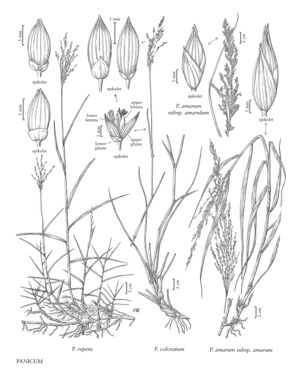Difference between revisions of "Panicum amarum subsp. amarulum"
FNA>Volume Importer |
imported>Volume Importer |
||
| (8 intermediate revisions by 2 users not shown) | |||
| Line 6: | Line 6: | ||
|synonyms={{Treatment/ID/Synonym | |synonyms={{Treatment/ID/Synonym | ||
|name=Panicum amarulum | |name=Panicum amarulum | ||
| − | |authority= | + | |authority= |
| + | |rank=species | ||
}} | }} | ||
|hierarchy=Poaceae;Poaceae subfam. Panicoideae;Poaceae tribe Paniceae;Panicum;Panicum subg. Panicum;Panicum sect. Repentia;Panicum amarum;Panicum amarum subsp. amarulum | |hierarchy=Poaceae;Poaceae subfam. Panicoideae;Poaceae tribe Paniceae;Panicum;Panicum subg. Panicum;Panicum sect. Repentia;Panicum amarum;Panicum amarum subsp. amarulum | ||
| Line 15: | Line 16: | ||
}}<!-- | }}<!-- | ||
| − | --><span class="statement" id="st-undefined" data-properties=""><b>Plants </b>with short (usually) or ascending rhizomes. <b>Culms</b> usually 100-250 cm, robust, decumbent, densely bunched (occasionally with more elongated rhizomes and less bunching in the southern part of its range). <b>Panicles</b> usually more than 5 cm wide, spikelet density high; primary branches usually 2 or more per node, smooth to moderately scabrous, usually with quaternary branching. <b>Spikelets</b> 4-5.9 mm; lower glumes 3-5-veined, veins less evident than in subsp. amarum, midvein smooth distally.</span><!-- | + | --><span class="statement" id="st-undefined" data-properties=""><b>Plants </b>with short (usually) or ascending rhizomes. <b>Culms</b> usually 100-250 cm, robust, decumbent, densely bunched (occasionally with more elongated rhizomes and less bunching in the southern part of its range). <b>Panicles</b> usually more than 5 cm wide, spikelet density high; primary branches usually 2 or more per node, smooth to moderately scabrous, usually with quaternary branching. <b>Spikelets</b> 4-5.9 mm; lower glumes 3-5-veined, veins less evident than in <i></i>subsp.<i> amarum</i>, midvein smooth distally.</span><!-- |
-->{{Treatment/Body | -->{{Treatment/Body | ||
| − | |discussion=<p>Panicum amarum subsp. amarulum grows in swales behind the first dune and on sandy borders of wet areas. It extends as far north as northern New Jersey and extends southward into Mexico. It has been introduced to Massachusetts, West Virginia, Cuba, and the Bahamas.</p><!-- | + | |discussion=<p><i>Panicum amarum </i>subsp.<i> amarulum</i> grows in swales behind the first dune and on sandy borders of wet areas. It extends as far north as northern New Jersey and extends southward into Mexico. It has been introduced to Massachusetts, West Virginia, Cuba, and the Bahamas.</p><!-- |
| − | --><p>Panicum amarum subsp. amarulum is a fertile tetraploid, and possibly a progenitor of subsp. amarum, with which it intergrades in the Gulf region. Plants that intergrade with P. virgatum are evident in some coastal areas; they may represent hybrids.</p> | + | --><p><i>Panicum amarum </i>subsp.<i> amarulum</i> is a fertile tetraploid, and possibly a progenitor of <i></i>subsp.<i> amarum</i>, with which it intergrades in the Gulf region. Plants that intergrade with <i>P. virgatum</i> are evident in some coastal areas; they may represent hybrids.</p> |
|tables= | |tables= | ||
|references= | |references= | ||
| Line 28: | Line 29: | ||
-->{{#Taxon: | -->{{#Taxon: | ||
name=Panicum amarum subsp. amarulum | name=Panicum amarum subsp. amarulum | ||
| − | |||
|authority=(Hitchc. & Chase) Freckmann & Lelong | |authority=(Hitchc. & Chase) Freckmann & Lelong | ||
|rank=subspecies | |rank=subspecies | ||
| Line 35: | Line 35: | ||
|basionyms= | |basionyms= | ||
|family=Poaceae | |family=Poaceae | ||
| + | |illustrator=Linda A. Vorobik;Cindy Roché | ||
| + | |illustration copyright=Utah State University | ||
|reference=None | |reference=None | ||
|publication title= | |publication title= | ||
|publication year= | |publication year= | ||
|special status= | |special status= | ||
| − | |source xml=https:// | + | |source xml=https://bitbucket.org/aafc-mbb/fna-data-curation/src/200273ad09963decb8fc72550212de541d86569d/coarse_grained_fna_xml/V25/V25_1264.xml |
|subfamily=Poaceae subfam. Panicoideae | |subfamily=Poaceae subfam. Panicoideae | ||
|tribe=Poaceae tribe Paniceae | |tribe=Poaceae tribe Paniceae | ||
Latest revision as of 17:56, 11 May 2021
Plants with short (usually) or ascending rhizomes. Culms usually 100-250 cm, robust, decumbent, densely bunched (occasionally with more elongated rhizomes and less bunching in the southern part of its range). Panicles usually more than 5 cm wide, spikelet density high; primary branches usually 2 or more per node, smooth to moderately scabrous, usually with quaternary branching. Spikelets 4-5.9 mm; lower glumes 3-5-veined, veins less evident than in subsp. amarum, midvein smooth distally.
Discussion
Panicum amarum subsp. amarulum grows in swales behind the first dune and on sandy borders of wet areas. It extends as far north as northern New Jersey and extends southward into Mexico. It has been introduced to Massachusetts, West Virginia, Cuba, and the Bahamas.
Panicum amarum subsp. amarulum is a fertile tetraploid, and possibly a progenitor of subsp. amarum, with which it intergrades in the Gulf region. Plants that intergrade with P. virgatum are evident in some coastal areas; they may represent hybrids.
Selected References
None.
